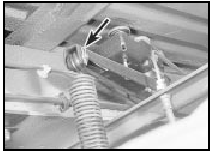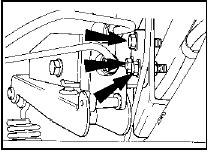Load apportioning valve P100 models) - removal and refitting
Caution: Refer to the precautions in Section 1.
Removal
1 Chock the front wheels, jack up the rear of
the vehicle and support on axle stands (see
“Jacking and Vehicle Support”).
2 The load apportioning valve is located on the right-hand side of the vehicle underbody above the axle.
3 Remove the spring clip and clevis pin, and detach the spring from the valve operating lever (see illustration).

24.3 Remove the spring clip (arrowed) and clevis pin from the valve operating
lever
4 Place a suitable container beneath the valve to catch spilt fluid, then unscrew the union nuts and disconnect the fluid pipes.
Plug the open ends of the pipes and valve to prevent fluid leakage and dirt ingress.
5 Unscrew the three securing nuts and bolts from the valve mounting bracket, and remove the valve assembly (see illustration).

24.5 Load apportioning valve securing bolts (arrowed)
Refitting
6 Refitting is a reversal of removal, but note
that the fluid inlet pipe from the master cylinder
must be connected to the lower valve port, and
the fluid outlet pipe to the rear brakes must be
connected to the upper valve port.
7 On completion, bleed the rear hydraulic circuit and check the valve adjustment.
See also:
Camshafts and cam followers - removal, inspection and refitting
Note: Once the timing chain has been
removed from the camshaft sprockets, do not
turn the crankshaft until the timing chain has
been correctly refitted - this is to prevent
contact between the val ...
Suspension and steering
The independent front suspension is of the MacPherson strut
type, incorporating coil springs and integral telescopic shock absorbers.
Lateral location of each strut assembly is by a forged or pres ...
Rear stub axle carrier Saloon and Estate models) - removal and
refitting
Removal
1 Raise and support the rear of the car on
stands (see “Jacking and Vehicle Support”).
Remove the roadwheel.
2 Remove the rear hub as described in
Section 9.
3 Remove the rear brake shoe ...
